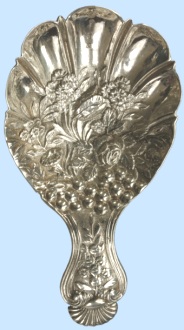
Food served with a cold spoon may cool down too quickly for some tastes. Even worse, a dish with rich, fatty gravy may congeal unappealingly on its way to your plate. A decorative container filled with hot water to keep serving spoons and sauce ladles warm seemed like the perfect solution in Victorian England. The earliest spoon warmers date from the 1860s.
This makes more sense when we remember how cold British houses could be for much of the year. Until the later 20th century rooms were often poorly heated, even in wealthy homes. Households with servants urged their staff to hurry from kitchen to dining room so food could be served hot, or at least warm, on heated plates. (Keeping the plates hot was a big deal, but that’s another story.) Hot food was appetising and proof of a well-run home too. Spoon warmers played their part in the effort to serve food at the right temperature – and fitted in with all the other paraphernalia in a fashionable late 19th century dining room.
Shapes and materials

A silver nautilus shell, open end upward, was a popular shape for a spoon warmer. Antique shell types are not hard to find today. Presumably they’re appreciated as decorative items and not used much.
Silver and silver plate warmers were common, but spoon warmers were also made from majolica, bone china and other pottery, and sometimes from brass or copper. As well as the favourite shell style, often on a seashore-themed base, there were frogs and fish with open mouths, helmets, or hunting horns on their side.
Designs ranged from elegant pieces of silversmithing and ceramics to absurd novelties. You could buy a neatly lidded spoon warmer to match your Royal Worcester dinner service, or a boat-shaped warmer or bright blue toad made by Minton. The best warmers kept the hot water mostly covered, with an opening just big enough for convenience.
Some were designed to double up as something else, like this one which could also be an egg coddler.
Not everyone was whole-heartedly enthusiastic about spoon warmers and other fancy dining accessories:
His table was a torment by reason of its patented aids to enjoyment. What with his radial carver, iris spoon-warmer, and folding cruets; his self-acting gravy-helper, excelsior asparagus-tongs, and duplex plate-warmer; his royal potato-parer, imperial cucumber-slicer, and oriental digester, to say nothing of patent wine-lifts, corkscrews, oxygen-generators, appetite-stimulators, and the rest of it, dining became a burden, and dessert a weariness of spirit.
M.E. Braddon, A Victim of Patents, July 1869 Belgravia
They went out of fashion early in the 20th century. It wasn’t long before magazines were suggesting you could use them as “novel” flower holders.
Photos
The museum exhibiting this spoon warmer along with a claret jug, also by Dresser, labels them both as “electroplate” and ebony. The metal part of the jug has a silver surface, but the spoon warmer looks like copper. Original nautilus shell photo.
More picture info here






